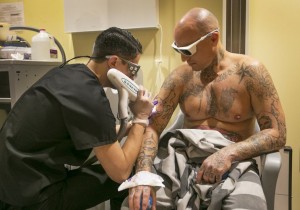
The Travis County Jail’s new pre-release tattoo-removal program is popular among its inmates.
While pre-release tattoo removal programs may be one of the best ways to give inmates the confidence they will need to start a new life post release, surprisingly few exist. In fact, we have only been able to identify five such programs in the entire country.
A new program at the Travis (Texas) County Jail, however, may provide a model for other correctional institutions to follow. The program was launched in early September as a unique partnership between the jail and the Austin-based Texas Laser & Aesthetics Training Academy, whose staff members donate their time for free.
The effort was the brainchild of Travis County Sheriff Greg Hamilton. “He brought us the idea, but it took quite a while to get the licensing to do it and be a traveling tattoo removal program,” says Katie Beck, the laser academy’s co-owner and clinic director.
Now that the licensing is in place, Beck and one of her head instructors travel to the jail every other week with a portable tattoo removal device. Wheeling their device into its medical facility, they spend six hours at the prison, during which they see about 25 patients.
The program is publicized in the jail’s programs area, where inmates go for GED and work readiness classes, and anyone can participate.
“They’re chosen just by request. We’re not turning anyone down,” says Kathryn Geiger, the Travis County Sheriff’s Department’s director of medical services.
The week before the procedures are performed, the Travis County Jail requires that participants undergo a physical examination by the jail’s medical provider. “They have to make sure that their body is capable of absorbing the dye,” says Geiger. “If they’re on any medicines that make them photo sensitive, they’ll stop those seven days before the procedure.”
The jail’s medical staff also requires those who receive treatment to come back the following day to meet with a wound care specialist, who ensures that the tattoo removal site is healing properly. They are also reminded to avoid the sun and keep the area moist with antibiotic cream.
Most of the tattoos are not particularly difficult to remove, according to the laser academy’s Beck. “These tattoos are usually homemade, so the depth of the ink is much easier to get at than ink that is very deeply inside of the dermis. It’s mostly prison tattoos,” she says.
Although the program is still new, follow-up treatments have already been scheduled with one former inmate who has been released. Any participant whose treatments haven’t been completed by the time they’re out can make additional appointments at the laser academy free of charge.
“They’re going to be my models for the classes. Not everyone wants students to work on them, but these guys are perfectly willing,” Beck says, confirming that the tattoo removal program has benefits for her school as well as the jail and its inmates.
Thus far, the program has been an overwhelming success. “Within the first week, we already had 97 requests,” said Geiger. “Even the officer staff has come and asked if we can start doing this for them.”
As the word spreads, more and more inmates are expected to want to participate. And many have stories that tell how important it is to them to get rid of their ink.
Here’s just one from Geiger.
“An inmate was sitting there listening to the presentation and left for the restroom,” she says. “He came out and said, ‘I wasn’t going to do this, but I went into the bathroom and saw myself in the mirror. I saw the teardrops and didn’t want to see them anymore.’”
Another inmate had a different reason that touched Beck.
“One gentleman is just 19 years old. He said he’s afraid he might be deported and doesn’t want to get killed by the cartel if he’s released,” she says.
That’s just one more reason why pre-release tattoo removal programs might be the solution for a variety of potential problems that inmates could face post-release.
For those thinking of starting a pre-release tattoo removal program of their own, Beck and Geiger have some advice:
- The state licensing for operating a mobile tattoo unit can be the hardest part, so you have to check with your state and see what the requirements are. Every state is different, but they all have a certain amount of bureaucracy, and that’s where you have to start.
- Look into your community to find other organizations or institutions you may want to partner with.
- Reach out to laser and aesthetic providers who might want to volunteer to perform the tattoo removals and/or the follow-up for free.
If anyone has any questions, please contact us, and we can refer you to the people who operate the Travis County Jail’s program.
Editor’s Note: Unfortunately this program – and its partnership with the Austin-based Texas Laser & Aesthetics Training Academy – ended when Sheriff Greg Hamilton retired.

